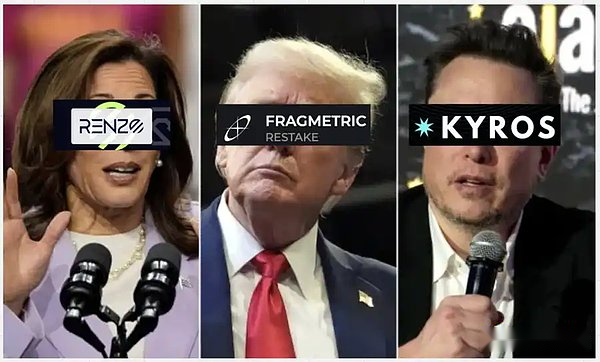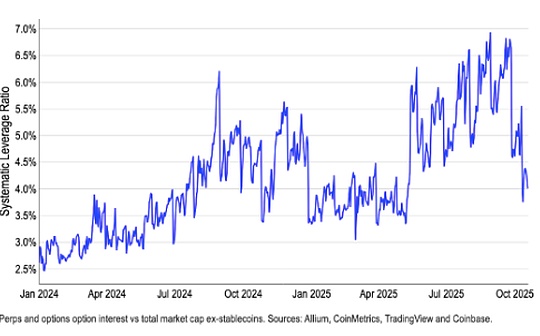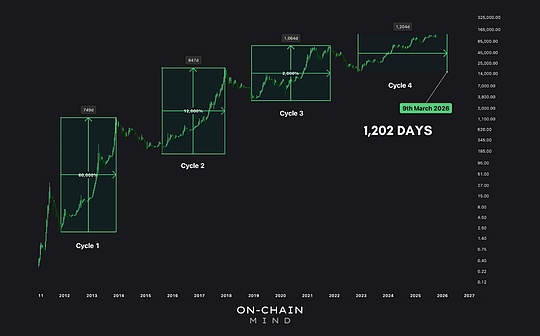
Original title: “JITO (Re) Staking is here-who will win the Solana RESTAKING RACE?”
Written article: Flow, Crypto Researcher
Compilation: zhouzhou, blockbeats
Editor’s note: This article introduces Jito Labs’s re -pledge agreement JITO (R) Staking, which is launched on Solana. This technology allows the use of pledged SOL assets to obtain higher returns and may participate in airdrops.Users can pledge SOL through three providers (Renzo, Fragmetric and Kyros). Each provider has different risks, liquidity and potential benefits.The text compares their characteristics in detail. It is recommended to choose Kyros, which supports fair startup and has potential airdrop returns.
The following is the original content (in order to facilitate reading understanding, the original content has been reorganized):
After successfully creating the largest mobile pledge agreement on Solana, Jito Labs brought another important development again: a new re -pledge agreement -JITO and pledge.This re -pledge project will be launched today and will be open to deposit soon. The initial pledge limit is about $ 25 million (147,000 SOL).This is a very attractive opportunity in the market for those who want to obtain a higher SOL annualized income and want to participate in the airdrop opportunity.
Before introducing how to maximize this opportunity, first briefly review the basic principles of JITO and then pledge.
What is JITO pledged again
Simply put, pledge refers to the use of pledged assets, and once again provides security guarantees for specific decentralized services.Although it seems not important, this is actually one of the most promising innovations in this cycle.The concept was first launched by Eigenlayer and was first launched on the Ethereum Master Network in June 2023.
>
Example description of actual operation
Today, JITO finally brought this new technology into Solana through its re -pledge plan.
>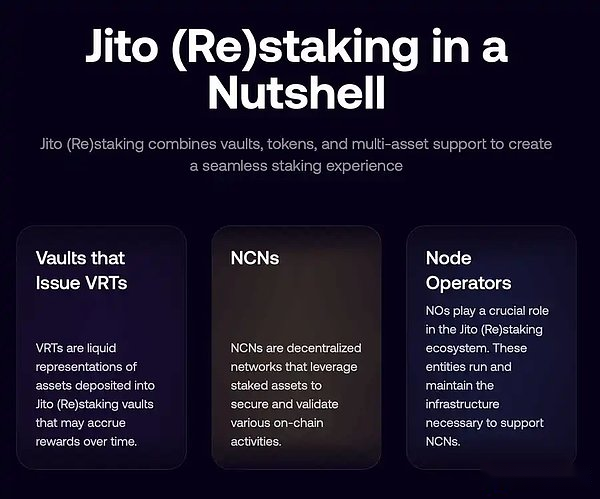
JITO’s schematic diagram of each component part
JITO’s core component of the backbound framework
The JITO re -pledge frame contains two main components: re -pledges and vault programs.They can be regarded as two independent entities that cooperate with each other to provide a flexible and scalable infrastructure to create and manage pledged assets, vault receipt tokens (VRT), and node consensus operators (NCN).VRT is the term of JITO on the campaign to the flow, while NCN is similar to an active verification service in Eigenlayer, which is used to represent the entity that uses JITO to recover solutions.
The main function of the pledge program is to manage the creation of node consensus operators (NCN), user selection mechanism, and reward distribution and punishment mechanism.This part is not visible to users, and can be regarded as the core support of the Jito re -pledge solution.
The vault program is responsible for managing the flow of the campaign (VRT) and customized different pledge strategies through the DAO or automation protocol.This is the main interface for users to participate in re -pledge.The analogy is that Eigenlayer’s re -pledge character is held by the re -pledge program on Solana, while the vault program is similar to Etherfi, and acts as liquidity layer between the user and the core pledge protocol.
>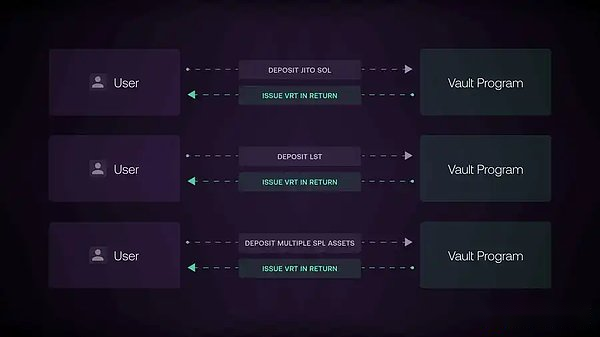
How to work in the Vault program how to work
3 VRT providers
In the early stages, Jito cooperated only with three VRT providers: Renzoprotocol ($ EZSOL), Fragmetric ($ Fragsol) and Kyrosfi ($ Kysol), and they will jointly allocate the initial upper limit of 147,000 SOL.Therefore, any user who wants to pledge SOL through Jito needs to make a choice among these three VRT providers.
>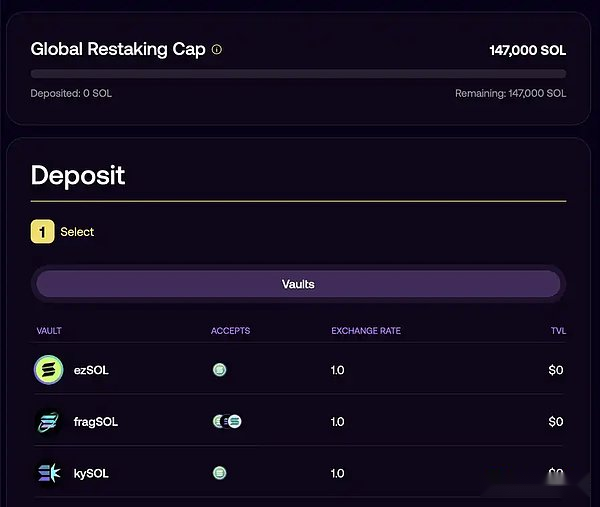
Jito (Re) login page image
The following are the main characteristics of the VRT providers:
>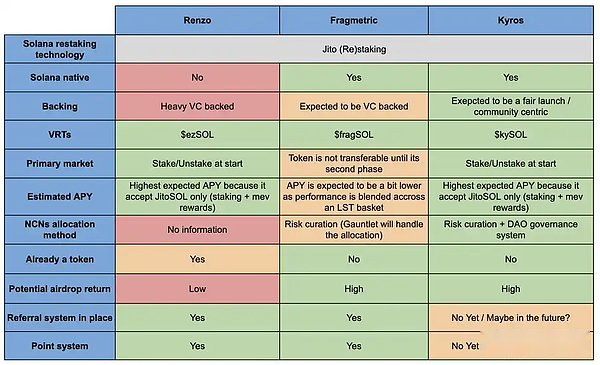
How to choose the right VRT for SOL and then pledge?
When you choose which VRT, the key is to find the best risk -return ratio.
The following is the analysis of each provider:
1. Risk: In terms of risks, it mainly focuses on the punishment of the agreement (that is, punishment risk) and liquidity risk.Because the current number of NCNs is small and in the early stages, the risks of all providers can be considered as basically the same.Renzo and Kyros are the best liquidity Jitosol, and Fragmetric accepts more types of liquid pledged tokens (LST), which may increase its liquidity risk.In addition, the VRT of Renzo and Kyros will have liquidity from the beginning, and Fragmetric’s tokens cannot be transferred in the early stage.Therefore, in terms of risks, Renzo and Kyros have the lowest risk, and Fragmetric risks are slightly higher.
2.APY returns: The APY of each project is expected to be similar, but it can be considered that Renzo and Kyros can use only Jitosol. It is expected that APY may be slightly higher than Fragmetric, but the gap will not be great.
3. Airdrop potential: Given that all VRT has similar risks and expected return, the key factor of choosing a specific VRT is the potential of airdrop rewards.Renzo already owns tokens. Although pledge may get some future air investment points, the potential is relatively low.Neither Kyros and Fragmetric are currently without token currencies, and the potential of airdrops is high.
Further analyze the difference between Kyros and Fragmetric:
Features of Fragmetric: It is expected to obtain venture capital support, which may follow high FDV and low circulation models; bias technology and decentralized user groups; cooperation with Gauntlet with risk management companies; token in the early stage of the currency; accepting multiple LST.
Features of Kyros: Get SWISSBORG support to help distribute $ Kysol and may cooperate with Solana’s main participants; it may be funded through a fair community -driven tokens; large -scale promotion has not yet begun; the NCN allocation method may be based on DAO voting; support Jitosol.
Taken together, KyrosFi is more attractive in many aspects.First of all, Swissborg’s support makes it easier to distribute $ kysol and open the door for its main partners with Solana.Secondly, Kyros may adopt a fair launch method.In the end, Kyros is relatively low -key, which makes its airdrop return potential more attractive.
Of course, this is a personal view that is for reference only. I hope this analysis will help you make a more wise decision when choosing to pledge SOL.
>